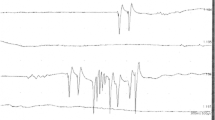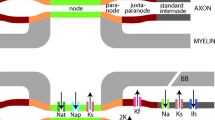Summary
Clinical, electrophysiological, and the nerve and muscle biopsy findings from a case treated with amiodarone are reported. Marked distal motor and sensory impairment and distal muscular atrophy were observed clinically. The electrophysiological examination revealed normal motor and sensory conduction velocities in the median nerve; the sensory action potentials were polyphasic and reduced in amplitude. Electromyography revealed denervation potentials and severe loss of motor units in the M. extensor digitorum brevis and in the M. tibialis anterior. The light and electronmicroscopical study of a N. suralis biopsy displayed total loss of large myelinated fibers and an almost total reduction of small myelinated fibers. The number of unmyelinated axons was markedly reduced. Fibrocytes and degenerative axons polymorphous inclusion bodies were present in Schwann cells. The muscle biopsy revealed both neurogenic and myopathic changes. Lipid storage was also present in the muscle fibers. Physical and chemical analysis of the nerve and muscle biopsy revealed the content of iodine to be more than 40 times increased. The findings indicate damage of axons, schwann cells and muscle fibers. It is suggested that the lipid storage in nerve and muscle tissue might be related to the accumulation of the drug or its metabolites.
Zusammenfassung
Es werden die Ergebnisse einer klinischen und elektrophysiologischen Untersuchung sowie die Nerven- und Muskelbiopsiebefunde eines Falles berichtet, der 7 Jahre lang mit dem Antiarrhythmikum Amiodarone behandelt wurde. Klinisch-neurologisch fand sich eine distale sensomotorische Neuropathie mit ausgeprägten distalen Muskelatrophien. Die neurophysiologische Untersuchung ergab normale motorische und sensorische Leitgeschwindigkeiten. Die sensorischen Nervenaktionspotentiale waren polyphasisch und zeigten eine niedrige Amplitude. Im M. tibialis anterior und im M. abductor pollicis brevis fanden sich bei der Nadelmyographie deutliche Denervierungszeichen. Die Untersuchung der N. suralis-Biopsie ergab einen kompletten Verlust der großkalibrigen und eine schwere Reduktion der kleinkalibrigen Markfasern. Auch die Anzahl der unbemarkten Axone war deutlich vermindert. Schwannzellen, Fibroblasten und degenerierte Axone enthielten zahlreiche polymorphe, lipidhaltige Einschlußkörper. Die Muskelbiopsie zeigte neurogene und myopathische Veränderungen. Auch Muskelfasern enthielten Lipidakkumulationen. Die physikalische und chemische Untersuchung des Nerven- und Muskelgewebes ergab eine 40- bis 100fache Vermehrung des Jodgehaltes. Die Befunde deuten auf eine Schädigung von Axon, Schwannzelle und Muskelfasern. Ein Zusammenhang zwischen Lipidspeicherung und Akkumulation des Medikamentes bzw. seiner Metaboliten im Nerven- und Muskelgewebe kann vermutet werden.
Similar content being viewed by others
References
Bockhardt, H., Drenckhahn, D., Lüllmann-Rauch, R.: Amiodarone-induced lipidosis-like alterations in ocular tissues of rats. Graefes Arch. klin. Ophthalmol. 207, 91–96 (1978)
Dailheu-Geoffroy, P.: Une possibilité thérapeutique nouvelle dans l'angine de poitrine: l'amiodarone. Gaz. méd. France 78, 2114–2120 (1971)
Dubowitz, V., Brooke, M. H.: Muscle biopsy. A modern approach. London: Saunders 1973
Fischer, C., Bady, B., Trillet, M., Schott, M.: Deux cas de neuropathie périphérique à l'amiodarone. La nouv. presse méd. 6, 3645–3646 (1977)
Kaeser, H. E.: Amiodarone — Neuropathie. Schweiz. med. Wschr. 104, 606–608 (1974)
Kaeser, H. E., Ulrich, J., Wüthrich, R.: Amiodaron — Neuropathie. Schweiz. Rdsch. Med. (Praxis) 65, 1121–1122 (1976)
Lhuillier, M., Gouin, B.: Amiodarone et tremblement. Nouv. Presse méd. 2, 2411 (1973)
Lüllmann-Rauch, R.: Personal communication (1978)
Lustman, F., Mensec, G.: Amiodarone and neurological side-effects. Lancet 1974 I, 568
Mussini, M., Hauwe, J. J., Escourolle, R.: Etude en microscopie électronique des lésions nerveuses, musculaires et cutanées déterminées par le maléate de perhexiline. Acta Neuropath. (Berl.) 38, 53–59 (1977)
Ochoa, J., Mair, W. G. P.: The normal sural nerve in man. II. Changes in the axons and Schwann cells due to ageing. Acta Neuropath. (Berl.) 13, 217–239 (1969)
Rosenbaum, M. B., Chiale, P. A., Halpern, M. S., Nau, G. J., Przybylski, J., Levi, R. J., Lazzari, J. O., Elizari, M. V.: Clinical efficiancy of amiodarone as an antiarrhythmic agent. Amer. J. Cardiol. 38, 934–944 (1976)
Staiger, R.: Light microscopic demonstration of drug induced myelin bodies in the liver of rats. Experientia 30, 385–386 (1974)
Author information
Authors and Affiliations
Additional information
Cordarone®, Labaz Laboratoires
Rights and permissions
About this article
Cite this article
Meier, C., Kauer, B., Müller, U. et al. Neuromyopathy during chronic amiodarone treatment. J. Neurol. 220, 231–239 (1979). https://doi.org/10.1007/BF00314147
Received:
Issue Date:
DOI: https://doi.org/10.1007/BF00314147




